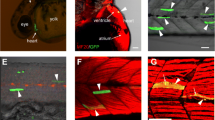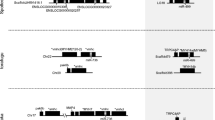Abstract
The human sarcomeric myosin heavy chain gene MYH14 contains an intronic microRNA, miR-499. Our previous studies demonstrated divergent genomic organization and expression patterns of myh14/miR-499 among teleosts; however, the regulatory mechanism is partly known. In this study, we report the regulation of myh14 expression in zebrafish, Danio rerio. Zebrafish myh14 has three paralogs, myh14-1, myh14-2, and myh14-3. Detailed promoter analysis suggested that a 5710-bp 5′-flanking region of myh14-1 and a 5641-bp region of myh14-3 contain a necessary regulatory region to recapitulate specific expression during embryonic development. The 5′-flanking region of zebrafish myh14-1 and its torafugu ortholog shared two distal and a single proximal conserved region. The two distal conserved regions had no effect on zebrafish myh14-1 expression, in contrast to torafugu expression, suggesting an alternative regulatory mechanism among the myh14 orthologs. Comparison among the 5′-flanking regions of the myh14 paralogs revealed two conserved regions. Deletion of these conserved regions significantly reduced the promoter activity of myh14-3 but had no effect on myh14-1, indicating different cis-regulatory mechanisms of myh14 paralogs. Loss of function of miR-499 resulted in a marked reduction in slow muscle fibers in embryonic development. Our study identified different cis-regulatory mechanisms controlling the expression of myh14/miR-499 and an indispensable role of miR-499 in muscle fiber–type specification in zebrafish.








Similar content being viewed by others
References
Akolkar DB, Kinoshita S, Yasmin L, Ono Y, Ikeda D, Yamaguchi H, Nakaya M, Erdogan O, Watabe S (2010) Fibre type-specific expression patterns of myosin heavy chain genes in adult torafugu Takifugu rubripes muscles. J Exp Biol 213:137–145
Asaduzzaman M, Kinoshita S, Bhuiyan SS, Asakawa S, Watabe S (2011) Multiple cis-elements in the 5′-flanking region of embryonic/larval fast-type of the myosin heavy chain gene of torafugu, MYHM743-2, function in the transcriptional regulation of its expression. Gene 489:41–54
Asaduzzaman M, Kinoshita S, Bhuiyan SS, Asakawa S, Watabe S (2013) Stimulatory and inhibitory mechanisms of slow muscle-specific myosin heavy chain gene expression in fish: transient and transgenic analysis of torafugu MYH(M86–2) promoter in zebrafish embryos. Exp Cell Res 319(6):820–837
Baxendale S, Davison C, Muxworthy C, Wolff C, Ingham PW, Roy S (2004) The B-cell maturation factor Blimp-1 specifies vertebrate slow-twitch muscle fiber identity in response to Hedgehog signaling. Nat Genet 36:88–93
Bell ML, Buvoli M, Leinwand LA (2010) Uncoupling of expression of an intronic microRNA and its myosin host gene by exon skipping. Mol Cell Biol 30:1937–1945
Berg JS, Powell BC, Cheney RE (2001) A millennial myosin census. Mol Biol Cell 12:780–794
Bhuiyan SS, Kinoshita S, Wongwarangkana C, Asaduzzaman M, Asakawa S, Watabe S (2013) Evolution of the myosin heavy chain gene MYH14 and its intronic microRNA miR-499: muscle-specific miR-499 expression persists in the absence of the ancestral host gene. BMC Evolutionary Biol 13:122
Bhuiyan SS, Kinoshita S, Wongwarangkana C, Asakawa S, Watabe S (2016) Evolution and distribution of teleost myomiRNAs: functionally diversified myomiRs in teleosts. Marine Biotech 18(3):436–447
Chen JK, Taipale J, Cooper MK, Beachy PA (2002) Inhibition of hedgehog signaling by direct binding of cyclopamine to smoothened. Genes Dev 16:2743–2748
Crow MT, Stockdale FE (1986) Myosin expression and specialization among the earliest muscle fibers of the developing avian limb. Dev Biol 113:238–254
Darby IA, Bisucci T, Desmouliere A, Hewitson TD (2006) In situ hybridization using cRNA probes: isotopic and nonisotopic detection methods. Methods Mol Biol 326:17–31
Desjardins PR, Burkman JM, Shrager JB, Allmond LA, Stedman HH (2002) Evolutionary implications of three novel members of the human sarcomeric myosin heavy chain gene family. Mol Biol Evol 19:375–393
Devoto SH, Melancon E, Eisen JS, Westerfield M (1996) Identification of separate slow and fast muscle precursor cells in vivo, prior to somite formation. Devlopment 122:3371–3380
Elworthy S, Hargrave M, Knight R, Mebus K, Ingham PW (2008) Expression of multiple slow myosin heavy chain genes reveals a diversity of zebrafish slow twitch muscle fibers with differing requirements for Hedgehog and Prdm1 activity. Development 135:2115–2126
Fisher S, Grice EA, Vinton RM, Bessling SL, Urasaki A, Kawakami K, McCallion AS (2006) Evaluating the biological relevance of putative enhancers using Tol2 transposon-mediated transgenesis in zebrafish. Nat Protoc 1:1297–1305
Hatta K, Kimmel CB, Ho RK, Walker C (1991) The cyclops mutation blocks specification of the floor plate of the zebrafish central nervous system. Nature 350:339–341
Ikeda D, Ono Y, Snell P, Edwards YJ, Elgar G, Watabe S (2007) Divergent evolution of the myosin heavy chain gene family in fish and tetrapods: evidence from comparative genomic analysis. Physiol Genomics 32:1–15
Incardona JP, Gaffield W, Kapur RP, Roelink H (1998) The teratogenic Veratrum alkaloid cyclopamine inhibits sonic hedgehog signal transduction. Development 125:3553–3562
Kawakami K, Shima A, Kawakami N (2000) Identification of a functional transposase of the Tol2 element, an Ac-like element from the Japanese medaka fish, and its transposition in the zebrafish germ lineage. Proc Natl Acad Sci USA 97:11403–11408
Kawakami K, Takeda H, Kawakami N, Kobayashi M, Matsuda N, Mishina M (2004) A transposon-mediated gene trap approach identifies developmentally regulated genes in zebrafish. Dev Cell 7:133–144
Kimmel CB, Ballard WW, Kimmel RS, Ullmann B, Schilling FT (1995) Stages of embryonic development of the zebrafish. Dev Dyn 203:253–310
Kinoshita S, Ceyhun SB, Md A, Bhuiyan SS, Akolkar DB, Asakawa S, Watabe S (2018) Promoter analysis of the fish gene of slow/cardiac-type myosin heavy chain implicated in specification of muscle fiber types. Fish Physiol & Biochem 44(2):679–691
Kinoshita S, Bhuiyan SS, Ceyhun SB, Asaduzzaman M, Asakawa S, Watabe S (2011) Species-specific expression variation of fish MYH14, an ancient vertebrate myosin heavy chain gene ortholog. Fish Sci 77:847–853
Kobiyama A, Hirayama M, Muramatsu-Uno M, Watabe S (2006) Functional analysis on the 5’-flanking region of carp fast skeletal myosin heavy chain genes for their expression at different temperatures. Gene 372:82–91
Korzh V (2007) Transposons as tools for enhancer trap screens in vertebrates. Genome Biol 8(Suppl 1):S8
Liang CS, Ikeda D, Kinoshita S, Shimizu A, Sasaki T, Asakawa S, Shimizu N, Watabe S (2008) Myocyte enhancer factor 2 regulates expression of medaka Oryzias latipes fast skeletal myosin heavy chain genes in a temperature-dependent manner. Gene 407:42–53
McCarthy JJ, Esser AK, Peterson AC, Dupont-Versteegden EE (2009) Evidence of MyomiR network regulation of β-myosin heavy chain gene expression during skeletal muscle atrophy. Physiol Genomics 39:219–226
Ochi S, Westerfield M (2007) Signaling networks that regulate muscle development: lessons from zebrafish. Dev Growth Differ 49(1):1–11
Ono Y, Kinoshita S, Ikeda D, Watabe S (2010) Early development of medaka Oryzias latipes muscles as revealed by transgenic approaches using embryonic and larval types of myosin heavy chain genes. Dev Dyn 239:1807–1817
Quiat D, Voelkar Pei KA, Grishin J, Grange RW, Bassel-Duby OEN (2011) Concerted regulation of myofiber-specific gene expression and muscle performance by the transcription repressor Sox6. Proc Natl Acad Sci USA 108:10196–10201
Roy S, Wolff C, Ingham PW (2001) The u-boot mutation identifies a Hedgehog-regulated myogenic switch for fiber-type diversification in the zebrafish embryo. Genes Dev 15:1563–1576
RStudio team, (2020) RStudio: integrated development for RStudio. PBC, Boston, MA
Schmittgen TD, Livak KJ (2008) Analyzing real-time PCR data by the comparative C(T) method. Nat Protoc 3:1101–1108
van Rooij E, Quiat D, Johnson BA, Sutherland LB, Qi X, Richardson JA, Kelm RJ Jr, Olson EN (2009) A family of microRNAs encoded by myosin genes governs myosin expression and muscle performance. Dev Cell 17:662–673
von Hofsten J, Elworthy S, Gilchrist MJ, Smith JC, Wardle FC, Ingham PW (2008) Prdm1- and Sox6-mediated transcriptional repression specifies muscle fiber type in the zebrafish embryo. EMBO Rep 9:683–689
Wang X, Ono Y, Tan CS, Chai RJ, Philip C, Ingham PW (2011) Prdm1a and miR-499 act sequentially to restrict Sox6 activity to the fast-twitch muscle lineage in the zebrafish embryo. Development 138:4399–4404
Weiss A, McDonough D, Wertman B, Acakpo-Satchivi L, Montgomery K, Leinwand KR, L, Krauter K, (1999a) Organization of human and mouse skeletal myosin heavy chain gene clusters is highly conserved. Proc Natl Acad Sci USA 96:2958–2963
Weiss A, Schiaffino S, Leinwand LA (1999b) Comparative sequence analysis of the complete human sarcomeric myosin heavy chain family: implications for functional diversity. J Mol Biol 290:61–75
Westerfield M (1993) The zebrafish book. University of Oregon Press, Eugene, A guide for the laboratory use of zebrafish (Danio rerio)
Wilson KD, Hu S, Venkatasubrahmanyam S, Fu JD, Sun N, Abilez OJ, Baugh JJ, Jia F, Ghosh Z, Li RA (2011) Dynamic microRNA expression programs during cardiac differentiation of human embryonic stem cells: role for miR-499. Circ Cardiovasc Genet 3:426–435
Yasmin L, Kinoshita S, Akolkar DB, Asaduzzaman M, Ikeda D, Ono Y, Watabe S (2010) A 5′-flanking region of embryonic-type myosin heavy chain gene, MYHM743-2, from torafugu (Takifugu rubripes) regulates developmental muscle-specific expression. Comp Biochem Physiol 6:76–81
Yeung F, Chung E, Guess MG, Bell ML, Leinwand LA (2012) Myh7b/miR-499 gene expression is transcriptionally regulated by MRFs and EOS. Nucleic Acids Res 40:7303–7318
Funding
This study was partly supported by a Grant-in-Aid for Scientific Research from the Japan Society for the Promotion of Science and by the start-up package from Texas A&M International University.
Author information
Authors and Affiliations
Contributions
S.H. and S.K. conceived and designed the study and performed the experiments. S.H. performed the data acquisition and interpretation. S.A. and S.W. participated in research design and coordination. S.H. wrote the manuscript.
Corresponding author
Ethics declarations
Competing Interests
The authors declare no competing interests.
Additional information
Publisher's Note
Springer Nature remains neutral with regard to jurisdictional claims in published maps and institutional affiliations.
Supplementary Information
Below is the link to the electronic supplementary material.
Rights and permissions
About this article
Cite this article
Hasan, S., Asakawa, S., Watabe, S. et al. Regulation of the Expression of the Myosin Heavy Chain (MYH) Gene myh14 in Zebrafish Development. Mar Biotechnol 23, 821–835 (2021). https://doi.org/10.1007/s10126-021-10066-z
Received:
Accepted:
Published:
Issue Date:
DOI: https://doi.org/10.1007/s10126-021-10066-z




